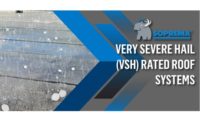In 2022, insured losses from hailstorms topped $10 billion in the United States for the 15th year in a row. Hailstorms account for 70 percent of the average annual property losses from severe convective storms in the U.S., according to the National Center for Atmospheric Research (NCAR).
Hail resistance is one of the performance requirements included in Approval Standard 4470 (“Single Ply, Polymer-Modified Bitumen Sheet, Build-Up Roof (BUR) and Liquid Applied Roof Assemblies for Use in Class 1 and Noncombustible Roof Deck Construction”). In the past, the hail resistance classifications included Moderate Hail (MH) and Severe Hail (SH).
In March 2018, the FM Global Property Loss Prevention Data Sheet 1-34 (Hail Damage) was updated and included a new Very Severe Hail (VSH) classification to the hail resistance design guidelines. This was a change to reflect updated data on relative hail sizes during a 15-year mean recurrence interval (MRI) and in direct reaction to the increased frequency of hail-related claims for storms with greater than 2” diameter hail. The maps for the three hail hazard areas were also updated with the new VSH classification applying to a large area in the central United States, including 14 states from Texas to the Dakotas.
Who stands to be one of the most impacted by the Very Severe Hail classification? The commercial roofing industry, of course, but it goes beyond that: the concept is designed to help commercial property owners prevent or reduce the potential for hail loss overall.
The Entities Behind the Very Severe Hail Designation
Behind the designation is FM Approvals, a third-party testing and certification laboratory with the unique focus of testing products for property loss prevention using rigorous standards. FM Global is one of the world’s largest property insurance companies, operating on the belief that the majority of loss is preventable, not inevitable, based on scientific research and risk engineering.
How do these two entities work together? FM Global, through their loss prevention data sheets, recommends the use of FM Approved roof systems. These exacting standards help reduce the chance of property loss due to fire, weather conditions, and failure of electrical or mechanical equipment.
How the Hail Damage Testing was Completed: In-Depth
Assemblies of various roofing materials are selected and tested using the following methods:
For Moderate Hail, using Approval Standard 4470’s procedure, roof systems are tested against a two-inch in diameter steel ball dropped from a height of 81 inched in a tube section. The ball weighs 1.19 lbs. The result is an impact energy of about eight foot-pounds on the surface of the roof system being tested.
Roof systems tested for Severe Hail are impacted with the same two-inch in diameter steel ball as with Moderate Hail, but the ball is dropped from a height of 141.5 inches. The resulting energy impact is that of 14 foot-pounds on the surface of the roof assembly.
For the new Very Severe Hail designation, two-inch in diameter ice balls are propelled at the roof assembly being tested using an ice ball launcher. The ice balls are propelled at between 152-160 feet per second, with the resulting impact energy coming in at 53-58 foot-pounds on the surface of the roof assembly being tested. This impact energy is the equivalent of a hailstone measuring up to 2.5 inches (64 mm) falling at terminal velocity.
Why ice balls for VSH? Ice balls – as opposed to steel balls – make the test as realistic as possible by targeting a specific density of ice to ensure consistency.
The membrane is evaluated through all three phases of the test program. Test 1: unconditioned membrane over test assembly. Test 2: membrane is UV conditioned for 1000 hours, then tested. Test 3: the membrane is UV conditioned and heat aged for 1000 hours prior to placing into assembly and testing.
What is the Geographical Reach of the Very Severe Hail Designation?
From the central plains states/central North Dakota south through Texas. Included in this area: North Dakota, South Dakota, Montana, Wyoming, Minnesota, Nebraska, Iowa, Colorado, Kansas, Missouri, New Mexico, Oklahoma, Arkansas, and Texas.
This area was designated as a Very Severe Hail region based on information from the National Oceanic and Atmospheric Administration’s (NOAA) National Weather Service and National Center for Environmental Protection’s Storm Prediction Center.
Impact of the Very Severe Hail Designation on the Commercial Roofing Industry
The biggest difference: significantly improved resistance to impact.
Initially, manufacturers combined existing products to meet the new VSH criteria. Now we’re seeing products specifically engineered to meet the VSH criteria. The industry is responding, which is always a good thing.
In 2019, there were about 1,700 VSH-rated assemblies on the market; in 2020, following a pandemic year, there were just over 10,000 VSH-rated assemblies.
The Very Severe Hail designation is currently not a part of the International Building Code (IBC). However, FM Approved roof assemblies including those with the VSH designation will in fact meet many sections of the IBC.
Looking ahead, there are plans to modify or update other standards or classifications to account for damaging weather events, specifically within Approval Standard 4470. FM Approvals is researching adding a VSH rating option to Approval Standards for steep slope roofing, skylights and heat and smoke vents.
Complete information on the Very Severe Hail designation from FM Approvals may be found in the FM Global Property Loss Data Prevention Sheet 1-34 (Hail Damage). Visit www.fmglobaldatasheets.com; www.roofnav.com and www.fmapprovals.com.




